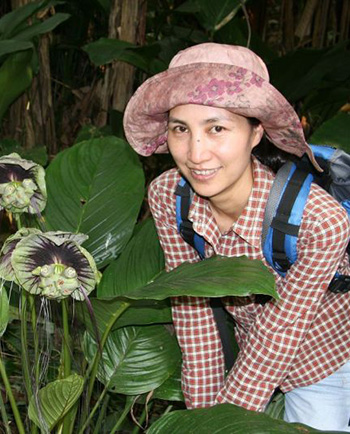学习经历
1987年9月—1991年7月,云南大学生物系植物学专业,获理学学士学位。
1994年5月—8月,日本的热川香蕉鳄鱼园进修学习。
1994年11月—1995年10月,英国的Muncaster Castle Garden进修学习。
2002年9月—2006年7月,中国科学院昆明植物研究所,获理学博士学位。
工作经历
1991年7月至1997年9月,西双版纳热带植物园任研究实习员。
1996年10月至1999年9月,曾任引种园林室树木园组组长。
1997年10月任助理研究员。
1999年9月至2003年12月,西双版纳热带植物园“动植物生态与进化关系组”任助理研究员。
2007年1月至12月,美国国家自然历史博物馆植物学部,博士后
2004年1月2012年5月,西双版纳热带植物园“动植物生态与进化关系组”任副研究员。
2012年6月至今,在西双版纳热带植物园“动植物生态与进化关系组”任研究员。
获奖情况
2002年度获云南省自然科学一等奖(排名第4)。
2003年10月获“云南省优秀科学论文特等奖”(排名第4)。
2004年度被西双版纳州妇联评为全州“三八”红旗手。
代表论著
Zhang L, Li QJ, Deng XB, GaoJY and Ren PY. 2003. Reproductive biology of Alpiniablepharocalyx (Zingiberaceae): another example of flexistyly. Plant Systematics and Evolution. 241:67-76.
Zhang L, Barrett S, Gao JY, Chen J, Cole WW, Liu Y, Bai ZL and Li QJ. 2005. Predicting mating patterns from pollination syndromes: The case of “sapromyiophily” in Taccachantrieri(Taccaceae). American Journal of Botany.92 (3): 517-524.
Zhang L, Li QJ, Li HT, Chen J, Li DZ. 2006. Genetic diversity and geographic differentiation in Taccachantrieri(Taccaceae): an autonomous selfing plant with showy floral display. Annals of Botany. 98: 449-457.
Zhang L, Chen J, Li DZ, and Li QJ. 2007. Reproductive Biology, Mating System, and Population Genetics of Devil Flower: An Autonomous Selfing Plant with Showy Floral Display. Floriculture and Ornamental Biotechnology. 1 (2): 115-124.
Zhang L and Li QJ. 2008. A new species of Tacca (Taccaceae) from the west of Yunnan, China. AnnalesBotaniciFennici. 45(4): 311-314.
Zhang L, LiHT, GaoLM, YangJB, LiDZ, CannonCH, ChenJ, LiQJ. 2011.Phylogeny and evolution of bracts and bracteoles in Tacca (Dioscoreaceae). Journal of Integrative Plant Biology. 53(11): 901-911.
Zhao YM & Zhang L*. 2015. The phylogeographic history of the self-pollinated herb Tacca chantrieri (Dioscoreaceae) in the tropics of mainland southeast Asia.Biochemical Systematics and Ecology.58: 139-148.
Luo YH, Sui Y, Gan JM & Zhang L*. 2016. Host compatibility interacts with seed dispersal to determine small scale distribution of a mistletoe in Xishuangbanna, southwest China. Journal of Plant Ecology. 9: 77–86.
Yan J, Wang G, Sui Y, Wang ML, Chen J & Zhang L*.2016. Pollinator responses to floral colour change, nectar, and scent promotereproductive fitness in Quisqualisindica(Combretaceae). Scientific Reports6: 24408; doi: 10.1038/srep24408.














